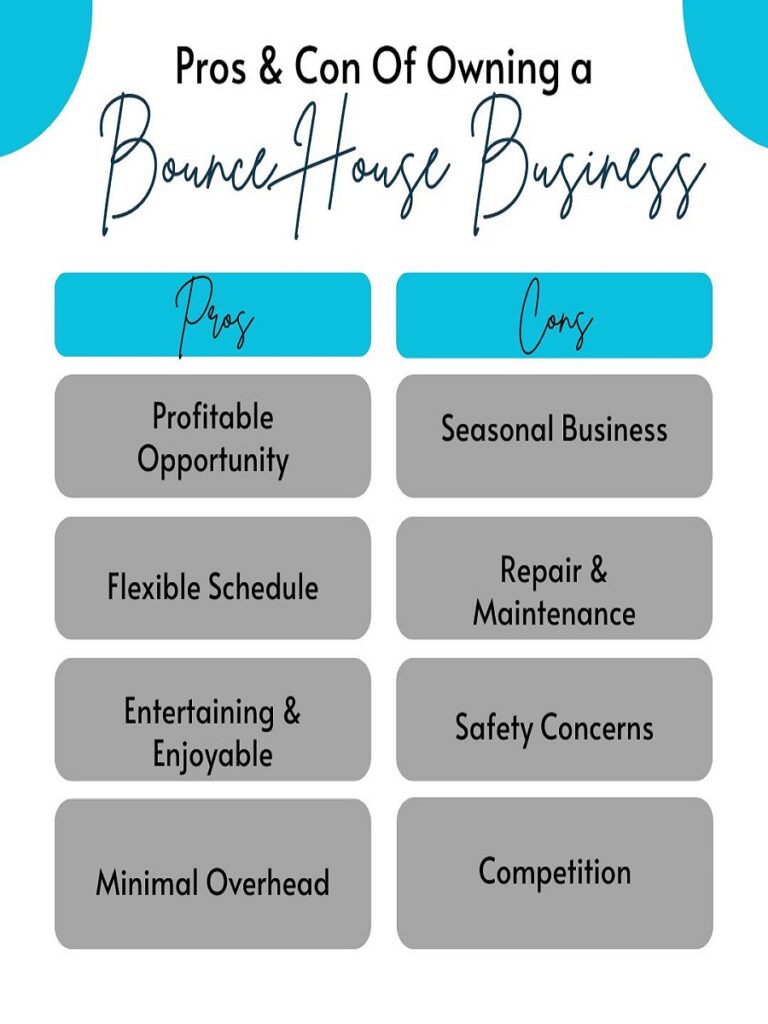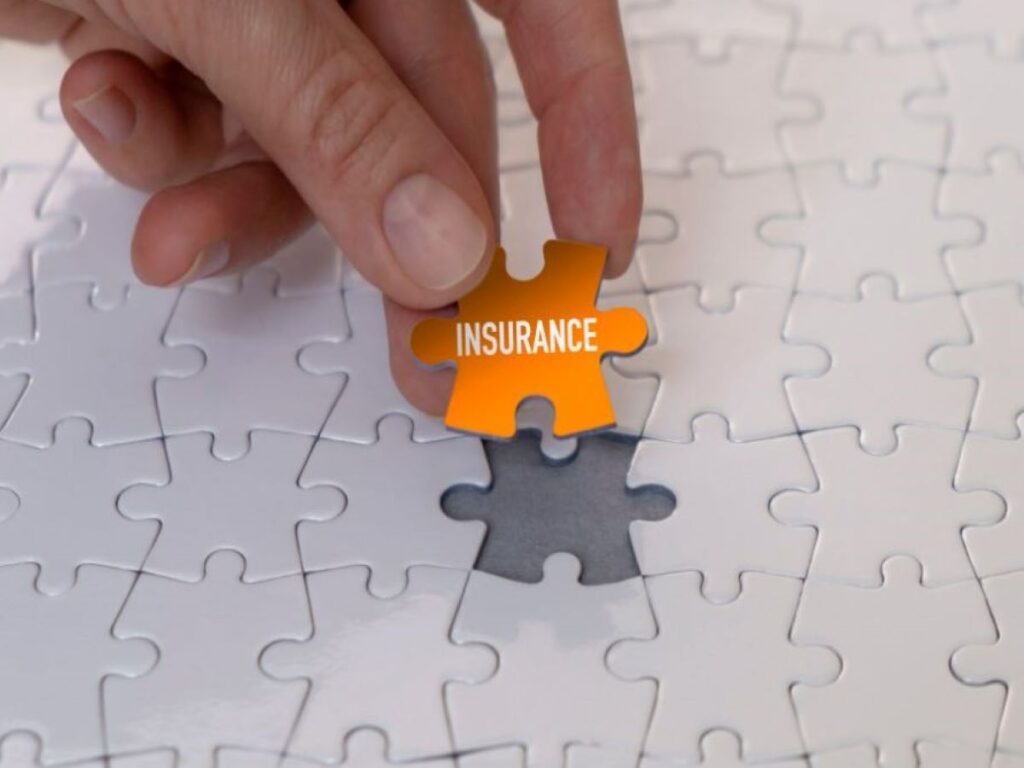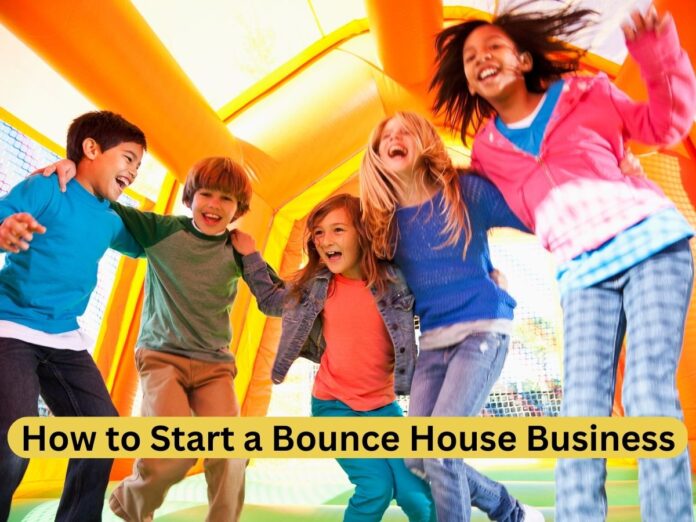Starting a bounce house business can be a lucrative and rewarding venture. Whether you are an experienced entrepreneur or just starting out, this guide will help you understand market trends, legal requirements, investment requirements, equipment and supplies required, and best practices for maintaining and expanding your business. It will also discuss marketing and advertising methods for your organization to efficiently reach your target audience. It will also emphasize the benefits and drawbacks of operating a bounce house business, as well as the potential risks and obstacles associated and how to mitigate them.
Thus, if you’re ready to take the plunge and start your own bounce house business, consider this guide to be your go-to resource for all of your concerns and inquiries. Let’s get this party started!
Pros and Cons of owning a Bounce House Business
Starting a bounce house business can be an exciting and lucrative opportunity, but it also comes with its own set of challenges and risks. Here are some of the advantages and disadvantages of operating a bounce house business, as well as the dangers and obstacles involved:

Pros:
- Profitable Opportunity: Bounce house enterprises can be profitable, particularly during peak seasons such as summer, when demand for outdoor entertainment is high. A bounce house business can create big revenue with the correct marketing and pricing plan.
- Flexible Schedule: As the owner of a bounce house business, you may determine your own schedule and work hours. This is especially advantageous for those seeking a more flexible work-life balance.
- Entertaining and Enjoyable: Running a bouncy house business may be a lot of fun. You get to entertain and delight children and families, which may be a fulfilling experience.
- Minimal Overhead: Bounce house businesses have comparatively low overhead expenditures as compared to other types of enterprises. This is due to the lack of a physical storefront, and the equipment can be stored in a garage or storage facility.
Cons:
- Seasonal Business: Bounce house enterprises are highly dependent on the weather. Demand for outdoor entertainment may be low during the winter months or during periods of rain, which can have an influence on revenue generated.
- Maintenance and Repairs: Maintaining and repairing bounce house equipment can be costly and time-consuming. Inflatable buildings are readily damaged, and repairs are costly.
- Safety Concerns: As the owner of a bounce house business, you are accountable for the children that utilize your equipment. Any accidents or injuries can result in legal and financial ramifications.
- Competition: The bounce house sector can be competitive, particularly in places where numerous organization offer identical services. This can make attracting and retaining clients difficult.
Risks and Difficulties:
- Insurance and Liability: Bounce house firms must have enough insurance coverage to protect themselves in the event of an accident or injury. Liability insurance is essential because it protects the company from the legal and financial implications of accidents or injuries.
- Rules and Permits: Operating a bounce house business in many states and municipalities necessitates the acquisition of numerous permits and licenses. These regulations might be difficult and time-consuming to understand.
- Transportation and Logistics: Transporting and erecting bounce house equipment necessitates the use of a large vehicle and numerous personnel to lift and transport the equipment. This might be difficult, especially for businesses on a smaller size.
- Marketing and Advertising: In order to attract clients and produce money, a bounce house firm must use effective marketing and advertising. Yet, marketing and advertising may be pricey, and standing out in a competitive industry can be difficult.
Quick Facts – Bounce House Business
| Industry trend | Growing |
| Investment range | $10,000 – $50,000 |
| Revenue potential (annual) | $50,000 – $150,000 |
| Commitment | Part-time or Full-time |
| Time to build | 1-3 months |
| Profit potential (annual) | $20,000 – $100,000 |
1. Market Overview of Bounce House Business
The bounce house sector in the United States has been continuously rising over the years, and it is expected to reach $1.07 billion by 2027. According to IBIS World, around 3,000 bounce house rental companies operate in the United States, employing approximately 19,000 people.
The growing popularity of outdoor events such as birthday parties, weddings, and community meetings is one of the primary reasons for the expansion of the bounce house sector. Furthermore, bounce houses are frequently rented for school and church gatherings, festivals, and corporate functions.
The increasing demand for themed bounce houses is another factor driving the expansion of the bounce house market. To appeal to a wide range of customers, several rental firms provide a variety of themes, ranging from princess castles to superhero hurdles.
Furthermore, with the growth of internet markets like as Amazon and eBay, entrepreneurs can now purchase and resell bounce houses at a lesser cost, making it a more accessible company for those just starting out.
2. Develop a Business Plan
A comprehensive business plan is essential for the success of a bounce house business. A business plan acts as a road map for your company, outlining your objectives, plans, and tactics. Here are some of the most important reasons why a business plan is important when launching a bounce house business:
- Aids in the acquisition of funding: A well-written business plan is critical for obtaining funding from banks, investors, or other lenders. It illustrates your knowledge of the sector, your target market, and your financial projections, making it easier for lenders to assess your company’s feasibility and possible return on investment.
- Establishes reasonable goals: A business plan assists you in establishing realistic and achievable goals for your company. It enables you to examine your company’s strengths and shortcomings, identify prospective issues, and devise plans to address them. This keeps you focused and motivated as you strive towards your goals.
- Provides decision-making Framework: A business plan provides a framework for decision-making as you establish and grow your firm. It assists you in evaluating possibilities, assessing risks, and making sound decisions based on your goals and objectives.
- Shares your vision: A well-written business plan shares your vision for your company with team members, investors, and other stakeholders. It explains your mission, values, and strategy, assisting you in developing a shared feeling of purpose and dedication among all stakeholders in the organization.
Startup Stunners has been providing high-quality business plan writing services for years, and we’re ready to assist you in developing a complete, effective strategy that will move your company ahead.
Our team of professionals is committed to assisting you in achieving your company objectives and obtaining finance from banks, grants, or other sources. We’re here to help you succeed whether you’re a newbie, entrepreneur, or small company owner. Don’t put it off any longer; visit startupstunners.com/contact-us/ today and let us lead you to success!
3. Investment Required for Bounce House Business
The amount of money needed to establish a bounce house business depends on a variety of criteria, including the quantity and type of bounce houses, the geographic location, and the business strategy.
Startup Costs
The following are the major expenses you might anticipate when beginning a bounce house business:
- Cost of Purchase: The cost of purchasing or renting bouncy houses, inflatable games, and other equipment is included in this pricing. Depending on the amount and style of bounce houses you want to offer, the cost can range from $10,000 to $50,000 or more.
- Transportation costs: To carry the bounce houses to and from events, you will need a vehicle. Typically, a van or truck with a trailer is utilized for this function. The cost of buying or leasing a vehicle might range between $10,000 and $30,000.
- The cost of insurance: Liability insurance is essential for any bounce house business. It safeguards you from injuries or property damage caused by your equipment. Liability insurance can cost anywhere from $500 to $2,000 each year, depending on the policy limitations.
- Marketing costs: You will need to invest in marketing and advertising to promote your firm. This includes developing a website as well as designing business cards, flyers, and brochures. Marketing costs might range from $1,000 to $5,000 or more, depending on the marketing channels used.
Recurring expense
The recurring costs to consider when launching a bounce house business are as follows:
- Repair and maintenance costs: Bounce houses require regular maintenance and cleaning to ensure they are safe and in good working order. Cleaning the inflatables, mending any punctures or tears, and replacing any worn-out parts are all part of the process. The cost of maintenance and repairs varies according to the kind and size of the bounce houses as well as the frequency of use.
- Replacement Costs: Due to wear and tear, damage, or obsolescence, bounce houses may need to be replaced over time. The cost of replacement might vary depending on the type and size of the bounce houses, as well as the frequency with which they are replaced.
- Storage Costs: Bounce houses must be stored in a dry, clean, and secure location when not in use. This could include renting a storage container or warehouse space, which can cost $50 to $500 or more per month depending on the size and location.
- Insurance Costs: In addition to liability insurance, you may require property insurance to protect your equipment from loss or theft. Property insurance costs vary according to the value of your equipment and the coverage limits.
- Utility Costs: If you need to inflate or clean the equipment on-site, your bounce house business may incur utility fees such as power and water. The cost of utilities varies based on where you live and how often you use them.
4. Equipment and supplies for your Bounce House Business
Choosing the correct equipment and supplies is critical for success when beginning a bounce house business. This includes choosing the appropriate bounce house beginning kit as well as acquiring the essential inflatables, blowers, and accessories.
Bounce House Business Starter Kits:
There are a variety of bounce house starter kits on the market, and selecting the proper one is dependent on the size and type of business you want to establish. The following are the most frequent varieties of bounce house starter kits:
- The Basic Kit: Bounce House Starting Set contains a single inflatable bounce house, a blower, and a repair kit. They are suitable for new small firms and are less expensive, ranging from $800 to $1,500.
- Deluxe Bounce House Starting Kit: This kit contains a bounce house, slide, and obstacle course, as well as numerous blowers and a repair kit. They are appropriate for larger businesses and range in price from $3,500 to $6,000.
- Commercial Bounce House Starting Kit: Designed for commercial use, this package includes high-quality inflatable structures, several blowers, and a repair kit. These beginning kits are more expensive, with prices ranging between $7,000 and $10,000.
Inflatables:
When selecting inflatables, consider the size, age range, and theme of the inflatables. The following are some of the most popular inflatable constructions for bounce house businesses:
- Bounce Houses: The most prevalent inflatable structures, they are available in a variety of sizes and themes. Costs range between $500 and $2,500.
- Slides: These inflatables, which come in a variety of heights and patterns, are popular with older children. Costs range from $1,000 and $3,000.
- Obstacle Courses: These inflatables are ideal for larger gatherings since they include a variety of challenges such as tunnels, slides, and climbing walls. Costs range from $2,500 and $5,000.
Blowers
Blowers are required to inflate and maintain the inflatables. While selecting blowers, keep in mind the size and type of inflatables you’ll be employing. Blowers range in price from $100 to $500.
Accessories are also required for a successful bounce house business. Among the most crucial accessories are:
- Tarps: While not in use, these protect the inflatables from dirt and debris. Prices range between $20 and $100.
- Anchors: These are used to tie inflatables to the ground in order to keep them from shifting or tipping over. Prices range between $50 and $200.
- Repair Kits: They are used to repair any inflatable damage. Prices range between $50 and $200.
5. Legal and regulatory obligations for Bounce House Business
Establishing a bounce house business necessitates adhering to legal and regulatory regulations, such as getting permits and licenses. The particular standards differ from state to state, so it’s critical to research the regulations in your area.
Licenses and Permits:
- Business License: To operate any business, including a bounce house business, most states require a general business license. A business license might cost anywhere from $50 to $400 depending on the state.
- Sales Tax Permit: If you intend to sell or rent inflatables, you must obtain a sales tax permit from your state’s revenue department. A sales tax permit costs vary by state.
- Zoning Permit: To operate a bounce house business, several cities and counties require a zoning permit. A zoning permit might cost between $50 and $500 depending on where you live.
- Fire Department Permit: Bounce houses are classified an amusement ride in several states and require a permission from the local fire department. The cost of a fire department permit varies depending on where you live.
Special State Requirements:
- California: Bounce houses are considered amusement rides in California and require a permit from the state’s Bureau of Occupational Safety and Health. The permit costs between $20 and $75.
- Texas: A business license is required in Texas to operate a bounce house business. A business license costs between $50 and $300.
- New York: A permit is required to operate a bounce house business in New York. The permission costs between $50 and $500, depending on where you live.
- Florida: To run a bounce house business in Florida, a sales tax permit is required. The cost of a sales tax permit varies depending on where you live.
- Pennsylvania: To run a bounce house business in Pennsylvania, a zoning permission is required. A zoning permit costs between $50 and $300.
- Illinois: To run a bounce house business in Illinois, a fire department permission is required. The cost of a fire department permit varies depending on where you live.
- Ohio: A business license is required in Ohio to operate a bounce house business. A business license costs between $25 and $400.
- Michigan: A sales tax permit is required to operate a bounce house business in Michigan. The cost of a sales tax permit varies depending on where you live.
- Arizona: A business license is required in Arizona to operate a bounce house business. A business license costs between $50 and $400.
- Georgia: A sales tax permit is necessary in Georgia to operate a bounce house business. The cost of a sales tax permit varies depending on where you live.
It should be noted that these are the general standards and costs for each state. Regulations differ from city to city or county to city or county, so it’s critical to research the specific requirements in your area.
Learn more about licensing requirements in your state by visiting SBA’s reference to state licenses and permits.
6. Insurance for Bounce House Business
Insurance is a critical component of starting and running a bounce house business. Customers and operators alike may be at risk when using inflatable structures, and accidents can result in property damage, bodily injury, and even death. As a result, adequate insurance coverage is required to protect your company and its customers.

Insurance Types:
- General Liability Coverage: General liability insurance covers third-party bodily injury and property damage claims that may arise as a result of your company’s operations. Medical expenses, legal fees, and other related costs may be covered by this type of insurance.
- Commercial Property Insurance: Commercial property insurance protects your business property from damage or loss, such as inflatables, blowers, and accessories. This type of insurance can cover the costs of repair or replacement in the event of damage or theft.
- Workers’ Compensation Insurance: Workers’ compensation insurance protects your employees from work-related injuries or illnesses that occur on the job. This type of insurance can cover medical bills, lost wages, and other expenses.
- Commercial Auto Insurance: If you use a vehicle to transport your equipment, commercial auto insurance may be required to cover any accidents or damages that occur during transit.
Insurance Cost:
The cost of insurance for a bounce house business is determined by several factors, including the size of your company, the number of employees, the services you provide, and the level of coverage you require. A small bounce house company can expect to pay between $500 and $1,500 per year for liability insurance. Workers’ compensation insurance rates vary by state, and commercial property and auto insurance rates vary according to the value of your property and vehicles.
7. Market and advertise your Bounce House Business
Marketing and advertising are essential components of establishing and expanding your bounce house business. Consider the following strategies:
- Developing a Website: A website is essential for any business today because it allows customers to learn about your services, view your equipment, and book rentals online. The average cost of developing a website varies, but it can range from $1,500 to $5,000, depending on the site’s complexity.
- Social Media Marketing: Social media is an extremely effective tool for promoting your company and reaching out to potential customers. Create a business page on popular social media platforms such as Facebook, Instagram, and Twitter and post updates about your services, special offers, and events on a regular basis. Social media marketing costs vary, but you should budget between $500 and $1,500 per month for social media advertising and management.
- Local Advertising: Reaching out to potential customers through local media outlets such as newspapers, radio, and television can be an effective way to reach out to them. Local advertising costs vary by market, but you should budget between $500 and $2,000 per month.
- Encourage Customer Reviews: Customer reviews and testimonials are essential for establishing trust and credibility with prospective customers. Encourage happy customers to leave reviews on your website, social media pages, or popular review sites such as Yelp and Google My Business.
- Referral Program: One of the most effective forms of advertising is still word-of-mouth. Provide a referral program to encourage happy customers to refer their friends and family to your company. Customers who refer new business to you can receive discounts or other incentives.
8. Tips for Expanding your Bounce House Business
Effective strategies, good management practices, and excellent customer service are required to manage and grow your bounce house business. Consider the following best practices:
- Hiring reliable, responsible, and trustworthy employees is critical to the success of your business. Ensure that your employees are trained in safety procedures and customer service, and that they have the equipment and tools they need to do their jobs effectively.
- Scheduling is essential in the bounce house business to ensure that your employees are available when rentals are in high demand. Consider using scheduling software to manage employee schedules and ensure that all bookings have enough staff.
- In the bounce house business, providing excellent customer service is critical. Make sure you respond quickly to customer inquiries, answer questions, and address any issues or concerns.
- Increasing your equipment inventory with new and exciting inflatables can help your business grow and attract new customers. Consider adding water slides, obstacle courses, and other interactive inflatables to your inventory to provide customers with a broader range of options.
- Consider providing additional services to your customers to improve their experience and differentiate your company from competitors. Party planning, event setup, and catering are all services that can add value to your company and increase revenue.
Conclusion
Starting a bounce house business can be a profitable and exciting venture with the potential for significant growth. However, it requires careful planning and preparation to ensure its success. A well-developed business plan, understanding of legal and regulatory requirements, insurance coverage, and effective marketing strategies are all essential components for starting and growing a bounce house business.
Investing in high-quality equipment and supplies, managing staffing and scheduling, providing excellent customer service, and tracking business metrics are also crucial best practices for managing and growing your business.
Overall, with dedication, hard work, and a commitment to providing excellent customer service, you can build a successful and profitable bounce house business in the US market.
Frequently Asked Questions
Do you need a permit for a bounce house business?
Yes, you will likely need a permit or license to operate a bounce house business, and the requirements vary by state and local jurisdiction. For example, in California, you will need a state contractor’s license and a business license. You may also need a seller’s permit and a permit from your local government to operate the business.
What kind of insurance do I need for my bounce house business?
You will need liability insurance to protect your business in case of injury or property damage. The amount of insurance required varies depending on the state and local jurisdiction. For example, in California, you will need a minimum of $1 million in liability insurance.
How much does it cost to start a bounce house business?
The cost of starting a bounce house business varies depending on the equipment and supplies needed, insurance costs, and legal fees. A basic starter kit can cost around $2,500 to $4,000, and liability insurance can cost between $500 to $1,000 per year. In total, the startup cost can range from $5,000 to $20,000.
What are the most popular types of inflatables for a bounce house business?
The most popular types of inflatables for a bounce house business include basic bounce houses, combo units with slides and obstacles, water slides, and interactive inflatables like obstacle courses.
How can I market my bounce house business?
You can market your bounce house business through a website, social media, and local advertising, such as flyers and banners. Encouraging customer reviews and testimonials can also help attract new customers.
What kind of staffing do I need for my bounce house business?
The number of employees needed for a bounce house business depends on the size of the business and the number of bookings. A basic startup may only require one or two employees, while larger businesses may require several employees, including delivery drivers, setup and takedown crews, and customer service representatives.






